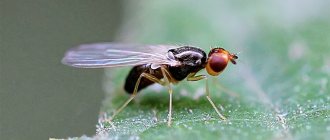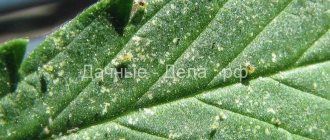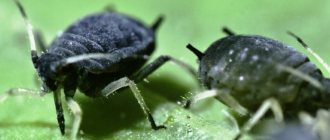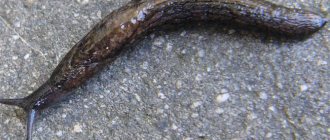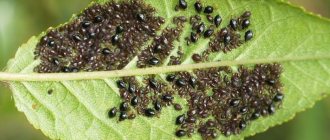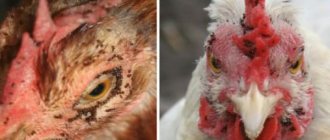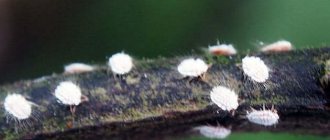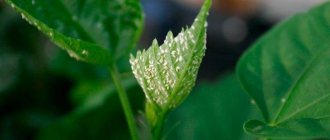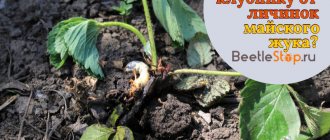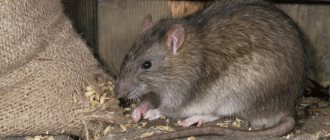With the beginning of spring, in April - May, young raspberry shoots begin to grow. However, among the young strong stems you notice wilted, bent tops of the shoots. Many gardeners think that this is due to lack of moisture or some kind of plant disease. In fact, it is a raspberry fly. The danger from proximity to the pest is that the fly lays its larva inside the stem. Subsequently leads to the death of the plant. How to deal with the raspberry fly and whether it is possible, read more in the article.
What harm does a raspberry fly cause?
The fly itself does not cause much harm to the shoots, but the larvae it lays pose a great danger to the plant. It affects the very first, strongest shoots. The crimson stem fly pierces a young stem in its upper part and lays eggs there. Sometimes it’s difficult to see the puncture, it’s quite small, but if you look closely you can see a hole and unhealthy dark tissue around it.
After 5-8 days, larvae develop from the eggs, small white oval worms up to 2-3 mm in size. The larva begins to move down the stem, eating away the middle of the stem. Naturally, the nutrition of the tops is disrupted. First, the leaves hang on the shoot and wither, and later the shoot dries out and dies. If you break the stem, you can see a larva there - a worm, as in this photo.
The larvae spend the winter in the upper layers of the soil, where they pupate, and with the onset of warmth in early spring, a new generation of flies crawls out of the ground. During the season, one fly can lay up to 90 eggs.
The main reasons for the appearance of the pest
The cause of the appearance of flies can be the following errors in care or mistakes when planting crops:
- The fly is a pest that also attacks blackberries, meadowsweet, meadowsweet and some other fruit bushes. Therefore, planting raspberries close to blackberry thickets or next to neighboring raspberry fields is a bad idea;
- the raspberry fly can be attracted by a significant number of aphids, which secrete a sweet liquid;
- Shrubs are vulnerable to summer residents who do not carry out preventive spraying against pests in the spring months, during the bud formation phase. This becomes especially important during years of mass fly breeding (due to favorable weather conditions);
- the fly overwinters in the surface layers of humus, which should be dug up to get rid of the pest. In dense raspberry fields this is a rather labor-intensive task, so it is most vulnerable to parasites;
- the pest can enter the garden with low-quality humus, which is used to mulch the soil under raspberry bushes.
The raspberry stem fly can destroy not only raspberry plantations, but also blackberry, meadowsweet and meadowsweet bushes. To avoid mass destruction of raspberries, it is necessary to fight by choosing truly highly effective methods and technologies.
The most attractive to flies are dense plantings, as well as plants weakened by frost or improper care. It is not difficult to fight insects, but you need to prevent massive damage to the planting
Control measures
To combat flies, chemical, biological and folk remedies are used.
Insecticides
Chemicals are used both for preventive purposes and to combat flies. It is important to remember that insecticide treatment is carried out in calm weather, preferably in the morning or evening, when the sun is low. Treatment can be carried out during the day, but in cloudy weather. Such restrictions are necessary so that after treatment, sunburn does not form on fragile leaves. Of course, such preparations cannot be used before rain.
Working solutions of these products are used to treat leaves and stems against flies and the soil under bushes to destroy the larvae.
The following tools can be used for processing:
- Karbofos is a moderately toxic drug; for use, 60 g of the product is diluted in 1 bucket of water. You must be careful if there are beehives nearby, as the drug has a detrimental effect on bees;
- Iskra is a broad-spectrum drug, including against the raspberry fly. 1 tablet of the product is diluted in 10 liters of water;
- Atellik - sold in 2 ml ampoules and 5 liter canisters. Before diluting the product, you must follow the instructions for use. Due to the strong toxicity of the drug, it can be used no more than twice per season;
- Condifor is a highly effective, low-toxic product; when processed, it seeps through the surface of leaves, stems, and roots. Protects the plant from flies for two weeks, so repeated treatments are required.
- Fufanon-nova is an effective systemic insecticide. The solution is applied according to the instructions, 1 ampoule is diluted in 5.5 liters of water.
All insecticides are poisonous, so when working with them, you must be careful and wear protective clothing, goggles, and gloves.
Biological drugs
- Fitoverm - the drug acts on a large number of flying insects. The effect occurs if the drug enters the gastrointestinal tract of the insect, but does not affect the larvae and pupae, since they do not feed. This product is safe for bees. The drug is diluted according to the instructions, the leaves and crown of bushes and trees are treated. After application, the solution must be used immediately. Harvesting can be done no earlier than after 2 days.
- Agravertine is an alcoholic extract of the soil fungus streptomyces. Once in the gastrointestinal tract of an insect, the drug begins to act within 12 hours, paralyzing the insect and causing its death after 3 days. The solution is applied according to the instructions and used immediately after its application. The effect of the drug is especially effective in hot weather.
Remember
- Start fighting the raspberry fly on time, because it multiplies very quickly and weakens the plants. If you start the situation, it will become much more difficult to remove it from the site.
- Follow preventive measures against flies, because it is much easier to prevent a disease than to treat it later.
- Care for raspberries properly, remember that pests most often attack weak plants.
- If possible, use folk remedies; they are much safer than store-bought ones, do not accumulate in the soil and are cheaper.
- Follow safety precautions when using chemicals: wear gloves and a respirator, wash your hands and face after handling.
Folk remedies and caring for raspberries
Proper and timely care of raspberries will prevent larvae from laying in the stems and will prevent larvae from developing in the soil. What is raspberry care?
- As soon as the first shoots begin to appear, inspect the raspberry tree once a week. When you see wilted young shoots, you must immediately cut them out and be sure to burn them. Cut the stem at ground level and even a little deeper into the ground;
- To repel flies, the bushes are irrigated with a solution of baking soda (2 tablespoons per bucket of water) and irrigated before the berries begin to set. For this purpose, someone sprays the bushes with mustard solution, which also helps;
- To prevent the raspberry fly from laying eggs, it is necessary that the larvae do not hatch into adults in the spring. For this purpose, mulching is carried out with a layer of at least 8 cm. Plant residues, peat, and sawdust are used as mulch;
- Remove old branches and young weak growth in a timely manner. They take on useful substances, the return from them will be minimal. The remaining young stems will take up more nutrients, grow stronger faster and cope better with pests and diseases. In addition, thickened raspberries are an ideal environment for flies;
- Treat raspberries in advance with biological preparations, they are harmless and effective, act on other pests, but are safe for bees;
- In the fall, after harvesting, collect fallen leaves, loosen the soil under the bushes; in loose soil, the pupae will freeze faster in winter. Loosen the soil carefully so as not to damage the root system. You can treat the soil with some insecticide.
Don’t forget to feed the bushes in the spring, then in the summer they will delight you with a bountiful harvest of sweet berries.
You can order the most productive raspberry varieties from the Gardens of Russia NPO.
I wish you a good harvest!
Prevention
As you can see, the raspberry fly is very dangerous, and the fight against it can take a long time. And in order to avoid troubles and prevent re-infection, it is necessary to act competently throughout the season. The quantity and quality of the harvest will depend on this.
Prevention is quite simple:
- regularly inspect the bushes in your raspberry patch and pay special attention to the condition of young shoots;
- if you know that there is definitely a raspberry fly in the neighboring area, then it would be useful to carry out preventive treatment with the drug “Karbofos” or “Actellik”;
- in spring and autumn, dig up the area and immediately collect all plant debris;
- Before winter, it is advisable to hill up all the bushes and cover the soil around them with mulch from compost or peat.
Remember, if you follow all precautions throughout the season, you can protect your raspberry tree from pest attack. And even if an infection occurs, do not give up, because now you know the methods of combating the raspberry stem fly. They are effective and easy to implement.
Treatment of raspberries from pests in autumn for winter
Treating raspberries against pests helps prevent the appearance of various mites that suck the juices from the plant. Most often, it is recommended to treat raspberries for pests in the fall, since most mites successfully overwinter in fallen leaves. Read on to learn how raspberries are treated against pests in the fall for the winter - the two most common types of mites are discussed.
Look at what common raspberry pests look like in the photo and continue to study the diversity of their species:
Raspberry mite
Raspberry mite Eriophyes gracilis Nal. - a very small pest, cylindrical in shape with two pairs of legs. Mites live and feed in leaf tissues, making moves and sucking out sap. In feeding areas, irregularly shaped bulges and folds form on the leaves - galls. The folds on both sides of the leaf blade are numerous, initially yellow-green, later becoming discolored. The veins of the affected leaves are severely bent, the leaf blades are deformed, lighten and dry out prematurely. Adult mites overwinter under the bud scales; in the spring, when they bloom, they penetrate into young leaves and feed on tissue sap. Over the summer, several generations of ticks develop.
Control measures. Preventive spraying when leaves fall in the fall with one of the drugs: fufanon, kemif, actellik. Repeated spraying is carried out immediately after raspberry flowering with the same preparations.
Common spider mite
Common spider mite Tetranychus urticae Koch. - a very small pest that feeds on the sap of young plant tissues. Has 4 pairs of legs. The body is 0.25-0.43 mm long, oval, greenish-yellow or orange-red. Females overwinter under plant debris and under the bark of trees and shrubs. In the spring, young leaves colonize, feed, weave thin webs and lay eggs.
The larvae of each generation, depending on weather conditions, develop from 8 to 20 days. During the growing season, more than 10 generations of the pest develop in open ground. Damaged leaves turn yellow, become deformed, turn brown and dry out. In most cases, the mite spreads from nurseries with planting material, as well as with various cut flowers and potted indoor plants. This pest damages over 200 species of various plants, including honeysuckle.
Control measures. Spraying plants when a pest appears and without fail in the fall before winter with one of the preparations: Fitoverm, Fufanon, Kemifos, Actellik, Lightning.
What to process
Treatment is carried out both with chemicals (urea, copper sulfate, dolomite flour, Bordeaux mixture) and folk remedies (mustard, soda, boiling water, infusions of herbs and flowers).
To strengthen the plants, treatment with urea is carried out in early spring. Take 15-20 grams per square meter. Urea saturates the bushes with nitrogen and makes them less susceptible to disease.
Treating raspberries with copper sulfate helps avoid the appearance of fungal diseases (gray rot, anthracnose). The raspberry stems and the soil around the bushes are processed. For spraying, take 50 grams of vitriol per 5 liters of water.
When fighting anthracnose, rust and powdery mildew, treating bushes with a 1% solution of Bordeaux mixture or iron sulfate, Topaz, Nitrofen helps.
The main reasons for the development of infections are high humidity and high acidity of the soil. Reducing watering reduces humidity. Acidity can be reduced using wood ash, slaked lime, and dolomite flour. Take 150 grams per square meter.
Mustard protects raspberries from weevil larvae.
Instead of mustard, you can take baking soda, dilute 2 tablespoons in 10 liters of water.
Treating the bushes and root circle with boiling water allows you to get rid of most pests. The procedure is carried out after the snow has melted and the soil has warmed up.
If the affected area is small, raspberry beetle larvae can be collected manually. Before flowering, the plant is treated with an infusion of wormwood and marigold. When using Agravertine and Agravertine, the treatment is carried out twice.
During budding, raspberries can be sprayed with tansy infusion.
For the infusion, take 350 grams of dry herbs or a kilogram of freshly harvested raw materials, 5 liters of water. The tansy is infused for a day, then boiled for half an hour, filtered and diluted with the same amount of water.
Mulching with pine needles protects against weevils and gray rot.
The sequence of measures to protect raspberries
Once the raspberry stem fly appears, it is necessary to fight it for a long time, both in spring and summer, and in autumn. The general plan of events is as follows:
- in early spring, as soon as the snow has melted, you should carefully dig up the entire area and thoroughly loosen the soil under the raspberry bushes;
- at the end of spring - around May, when the mass emergence of flies begins, if the drug allows (remember about the toxicity for pollinating insects), we treat with an insecticide;
- during the budding period, we cut out damaged stems and dispose of them immediately;
- in the fall, after harvesting, we again dig up the soil around the bushes, spill it with Bordeaux mixture and, if necessary, repeat the insecticidal treatment. During this period, it is better to use Karbofos.
Characteristic
As you can see in the photo, the raspberry, or stem, fly is a small insect with a pubescent body and a pair of transparent wings.
The dimensions are insignificant - the body length of an adult does not exceed 7 mm. The larva is a worm-like caterpillar, with a pale off-white body color, the size of which is about 5 mm. The larva has no legs; the mouthparts are located between the two anterior segments of the body. The adult caterpillar encloses itself in a barrel-shaped false cocoon that is brown in color. The parasites overwinter in this cocoon, usually in the top layer of soil. In May, when the substrate in the areas where the larvae are located warms up to +12…13°C, they pupate. Development in the pupa lasts about 7-9 days, after which adult flies emerge, whose years last from 8 to 10 days. In cold and rainy weather, the flight may take a little longer - up to 20 days. Under such conditions, most pupae die.
Emerging mature flies feed on flower nectar, dew and sugar secretions of other pest insects, after which the females lay eggs. They usually place eggs on the tops and in the axils of not yet formed leaves, young shoots and in the root shoots of raspberries.
The fertility of female raspberry stem flies is 60-90 eggs. Development in the egg takes from 5 to 8 days, after which the larvae emerge. Young growth bites into the middle of young stems and makes spiral and ring-like passages. The apical parts of damaged stems gradually wither, turn black and die over time. After 12-16 days, the larvae stop feeding. They gnaw through the stem and use the passages they make to descend into the soil for the winter. There they entangle themselves in a false cocoon and remain until spring.
On a note! The number of raspberry stem fly is limited by many predatory insects, especially ground beetles!
Preventive measures
Experienced gardeners know how difficult it is sometimes to remove some pests from a plot. In order not to resort to the frequent use of chemical, aggressive agents that can poison the soil, and in order to produce environmentally friendly berries, it is advisable to follow the basic rules of cultivation from the moment of planting the raspberry tree and throughout its entire life cycle. They include:
- When purchasing cuttings, you must carefully examine their root part and buds so as not to introduce insect larvae into the area;
- a year before planting, sow mustard, clover, and rye on the territory of the future raspberry field. Green manure can be sown between rows during the growing process. These plants nourish the soil with nitrogen fertilizers, loosen it, and most importantly, repel all kinds of pests;
- do not plant new varieties of raspberries in the area where they previously grew: potatoes, tomatoes, eggplants, strawberries, wild strawberries - crops affected by the same pests as raspberries;
- regularly and promptly cut and destroy affected branches, berry clusters, leaves;
- regularly pull out weeds on which insects and larvae remain overwintering;
- Apply fresh manure to the raspberry garden only in the fall. The larvae of insects and parasites must have time to die from frost and rotting fertilizer.
In many modern raspberry varieties, resistance against pests is genetically determined. Remontant varieties are also rarely attacked by uninvited guests, since most often gardeners remove the entire above-ground part of the bush, along with insects and larvae, before winter. But for the prevention and control of pests of simple raspberries, compliance with the simple but important conditions given above is required. Compliance with them will preserve the harvest, as well as the health of not only raspberries, but also many other plants on the site. After all, pests not only themselves infect shoots, leaves and berries, they are carriers of many diseases.
Appearance of an insect
The raspberry stem fly is a small insect, about 6-7 mm long. Their color is brown-gray. The raspberry fly winters under bushes - in the upper layers of the soil. The active breeding season of the pest begins in the spring and occurs in April and May, depending on the regions of the country. This happens during the period when young shoots begin to appear. A raspberry fly crawls out of the ground.
To recognize the pest, you should carefully look at the photo of the raspberry stem fly. By itself, it is harmless; problems begin after it lays white, oval-shaped microscopic eggs. In total, a raspberry fly is capable of laying 90 of them. As soon as this happens, changes in the plant become noticeable - gradual withering of the leaves begins.
Insects lay eggs in the axils of the upper parts of the leaves. After 5-8 days, larvae are born, having a cylindrical shape and a white color. It is they, and not white flies on raspberries, as people often say, that cause significant damage to the bushes, gnawing helical passages in the soft stems. As a result, the bases of young shoots are damaged. Recognizing a raspberry fly is quite simple. If the young shoots in the upper part of the bush become sluggish and turn black, this means that a raspberry fly has appeared. There are passages visible along the stems, and if you cut them, you can see the larva itself. If no action is taken, the plant will die or the number of young shoots that are fruitful will be greatly reduced.
The raspberry stem fly can destroy not only raspberries, but also blackberries, meadowsweet and meadowsweet. To avoid mass destruction of bushes, you should fight by choosing truly effective methods and methods.
The harmfulness of the weevil
Damage to strawberry and raspberry plantations is caused by both adult beetles and their larvae. At
In this case, the feeding of adult beetles on leaves is quite short-term and is not as harmful to plants as the destruction of buds during oviposition, which continues from the moment the strawberry buds appear until the appearance of raspberry berries.
The beetle causes enormous damage to early varieties of strawberries. This is due to the fact that pests destroy the first buds in them, from which the largest berries ripen. In later varieties, buds of the 2nd and 3rd order, which are not so important, are affected. Plants with a female type of flower are less affected, since their stamens are underdeveloped and provide less food for the larvae. On the other hand, weevils cause more damage to older plantations.
Raspberry stem fly: how to protect the crop?
27.01.2019
Many pests like to “robbery” in raspberry fields. If effective protective measures are not taken in time, you may be left not only without a harvest, but also without the plants themselves. To choose the appropriate control method, you need to know what a specific harmful insect is and how it works. This article will focus on the raspberry stem fly.
Description of the pest
The raspberry stem fly is a small brown-gray insect, no more than 0.7 cm in length. It spends the winter in the upper layers of the soil, right under raspberry bushes.
The timing of when the insect becomes active depends on the climatic conditions of the region. In the Caucasus it is April, in the Moscow region it is the beginning of May, in the Urals it is even later. During this period, raspberries actively produce young shoots, which the fly uses to lay eggs.
https://youtube.com/watch?v=pTmMJtp8rgU
Female stem flies are very fertile and can lay up to nine dozen microscopic eggs in the axils of raspberry leaves.
What harm does it do?
Problems for gardeners begin from the moment the fly lays eggs that are almost invisible to the eye. It will be possible to recognize the pest only when the leaves and stems of the raspberries begin to fade. This happens during the period when the larvae hatch from the eggs and begin to actively feed, gnawing labyrinths in the delicate leaf plates and moving onto the stems.
From the moment the eggs are laid until the raspberry stem fly larvae appear, 7-10 days pass.
Meadowsweet (meadowsweet) and blackberries are on a par with raspberries in terms of the taste preferences of the stem fly.
What methods to fight?
The raspberry fly should be fought before the female flies. If the larvae are allowed to hatch and begin feeding, young plants can die in just a few days.
Chemicals
To rid raspberries of stem flies, the following chemicals are used:
- Spark. It has the form of a tablet weighing 1 g, which is diluted in 10 liters. water. It is advisable to spray early in the morning or in the evening, in cool weather, so that the product lasts longer on the leaves.
- Karbofos. The effect is high, however, if the drug is used during the flowering period, it can kill the bees. The working solution is diluted immediately before treatments. Spraying is carried out at a temperature of at least +15 C, preferably in the evening. If the drug is applied before rain, there will be no effect.
- Actellik. An emulsion that affects the gastrointestinal tract of the pest. Sold in ampoules of 2 g or canisters, used before raspberries begin to bloom, because It also affects pollinators, such as bees.
When using chemicals, you should take care of your own protection. Protect your respiratory tract using personal protective equipment.
Traditional methods
Folk remedies are loved by gardeners for their harmlessness, accessibility, and the effect from them can be no worse than from a newfangled chemical product. To combat stem fly on raspberries, use:
- Mustard powder solution. You will need 150-200 g of mustard per 8-10 liters. warm water.
- Tansy decoction. 250 grams of dry or fresh herbs, simmer in a water bath in 2 liters of water for 30 minutes. Dilute to 5 liters and immediately treat the bushes.
- Water infusion of garlic. 200 g of garlic are crushed and infused in 3 liters of warm water in a warm place for 3 days.
- Dandelion infusion. Leave approximately a kilogram of the plant, ground together with roots, in a bucket for 2-3 hours.
- Infusion of onion peel. Fill 1 volume of husk with 2 volumes of water. Leave for at least 2-3 days, otherwise the solution will be ineffective.
- Onion infusion. For 10-12 l. Hot water will require 1 kg. chopped onion. Stir, wait 2-3 hours and process the raspberries.
To improve adhesion and to make the solutions stay longer on the leaves and stems, crushed laundry soap is added to them. Spraying with folk remedies that are harmless to bees is also possible during the raspberry flowering period.
Infusions of tobacco and bird cherry leaves, as well as wormwood, are effective as pest repellents that are used in early spring, during the growing season.
If you carefully care for raspberry plantations, the likelihood of a raspberry fly attack is greatly reduced. At the first sign of the presence of a pest, action must be taken immediately. The use of dangerous insecticides is justified only if the raspberries are in a neglected state and are already severely affected by the pest, and preventive measures and folk remedies have not helped.
Raspberry stem fly: how to protect the crop? Link to main publication
How to care for raspberries: top simple rules
If the plant is strong and healthy, it will be able to resist pests and diseases. How to properly care for raspberries:
| Landing To prevent raspberry bushes from getting sick, you need to plant them correctly. The distance between rows should be at least 1.5 meters, and between bushes in a row - at least 70 cm. It is also important to choose good planting material so as not to bring diseases to the site along with it. |
| Trimming In spring, raspberries produce many useless shoots. To increase productivity, you need to trim unnecessary branches every year. In early spring, trim the trunk to a height of 1.5 m and leave no more than 7 large, strong and fruit-bearing branches, so the berries will be much sweeter |
| Loosening and weeding Pest eggs can overwinter in old weeds and underground, so it is important to periodically loosen the soil under the raspberries to a depth of 6 cm and weed out the weeds, this will destroy the pest eggs |
| Watering Raspberries do not like drought, but excess water causes even more harm to them. In summer and spring, raspberry bushes need to be watered as needed, when the ground is completely dry, but in the fall, on the contrary, they need to be heavily watered to prepare for winter. |
| Top dressing It is important to feed raspberries on time so that they grow strong. How to feed raspberries:
Do not use fresh manure for feeding, as it may cause fungal root diseases. At the beginning of summer, you can spray raspberries with Bordeaux mixture to avoid insects |
For more information on how to properly care for raspberries, watch the video:
Reviews and advice from gardeners
It lasts for many years, but very weakly, so I simply cut off the dead stems. This year the attack was quite serious; in a week more than 1/2 of the young shoots died.
Sources
- https://beetlestop.ru/malinnaya-muha/
- https://zoolog.guru/drugaya-poleznaya-informacia/malinovaya-muha-borba-s-ney.html
- https://ofazende.ru/kak-borotsya-s-malinnoj-steblevoj-muhoj
- https://OgoOgorod.ru/sad/malina/malinovaya-muha.html
- https://rci76.ru/muhi-i-moshki/malinnaya-steblevaya-muha.html
- https://urozhajnayagryadka.ru/malinovaya-muha-foto-vred-posledstviya-kak-borot-sya/
- https://apest.ru/muhi/kak-izbavitsya-ot-muh/malinovaya-muha/
- https://jivovred.com/vsadu/malinovaya-muha-metody-borby
- https://vreditel-stoi.ru/sad/malina/malinnaya-muha.html
- https://qlumba.com/bolezni-rastenii/1227-vse-metody-borby-s-malinnoj-steblevoj-muhoj
- https://septik.guru/polezno-znat/malinovaya-muha-borba-s-ney.html
[collapse]
